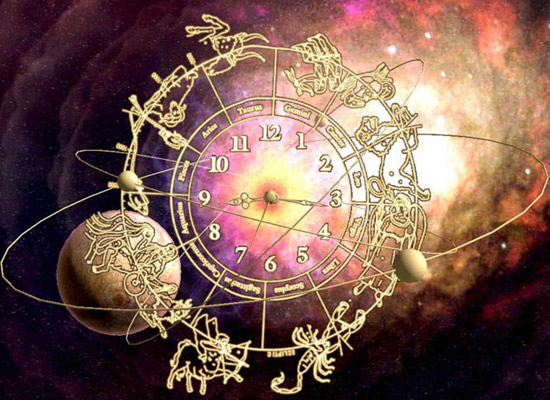- Belief
systems and both ancient and modern understandings of reality are considered
from the point of view of both Physics and Vedic Astrology. It is suggested
that many of our sceptical attitudes towards the teachings of the ancient seers
may be a product of our own incomplete knowledge of reality.
It
has been noted that the ancient authors of the Vedic texts and their students
who memorised and expounded the texts possessed a highly expanded and powerful
mental capacity based on a calm intuition and a clear insight.
Indeed,
it is hard for us to comprehend the genius of the rishis. Without computers
they made mental calculations which would be quite beyond the modern man.
Without telescopes, as far as we know, they accurately computed the positions
of the planets and developed an advanced understanding of astronomy and
astrology. There is evidence they knew the speed of light and much else only
recently determined.
Extracted
from the speech of Dr. Andrew Foss (PhD, MSc, MA (Oxon) Virginia, USA) at the
International conference on ‘Beliefs and Beyond’ at Bengaluru in March 2018.
To
read the article in PDF click on
PDF. Article is courtesy Bhavan’s Journal.
Throughout
the ancient world, primary science was clearly related to astronomy and astrology,
which we will call Jyotisha going
forward. There was need for a calendar and it has long been observed that there
are typically 12 full moons in the course of a Solar round.
Thus
the year and its months came into human consciousness.
It
was also observed that the Moon takes over 29 days between Full Moons and just
over 27 days to return to its original place. Thus, with respect to the Sun,
there were 30 days in the month in the form of Tithis and with respect to the Moon, there were 27 Lunar mansions or
Nakshatras.
The
Sun was ascribed a masculine quality and the Moon a feminine one, due to their
natural characteristics. As the world comes from the joining of the masculine
and the feminine, time and the world had to arise from a union of these two.
This
meant equating the dominant numbers of 12 and 27 since the Sun had 12 mansions
and the Moon 27. The simplest relationship is expressed as 12 x 9 = 27 x 4 =108.
From
this, the science of Jyotisha was born.
The
number 108 was declared to be Shree, the
source of all auspiciousness and a complete expression of divinity. Quite
naturally, the ancients enumerated the energies of these 108 sectors of the sky
assigning them key words.
Since
the divinity was Sarvavyapakesha, for
each sector there must be a divine name. Therefore, the sets of Astottarasatanama were developed. By
chanting all 108 names the complete glory of the divinity can be respected.
Vedic Wisdom and Quantum Mechanics
Quantum
Mechanics has shown that the universe has five fundamental forces and only
five. The theory breaks if there are any other number. Now the number five is a
core number in the Vedic science.
The
key emergence of five in Vedic cosmology is
the arising of the five tattvas or subtle elements. The Vedic cosmology starts
with One, the Brahman. Due to being consciousness, the prototype of the knower,
known and process of knowing are inherent in it.
Before
the five arose, the subtle agencies of knowing were there and the various
philosophies describe this in various ways. For example, in Sankhya, there are
the Ahamkara, Buddhi and Manas. After
the appearance of this subtle level, the physical reality begins with the
appearance of Akasha, then Vayu, Agni, Jala and Prithvi. This is described as
the Sristi or order of creation.
Akasha
Quantum
Physics has an identical order with closely similar characteristics.
First
space-time arises, which is associated with gravity whose particle is the
graviton (spin 2). This is the highest spin particle. Identifying Akasha with
space requires little imagination. The Vedic concept of Akasha is that which
contains and thus holds everything together.
Einstein’s
incorporation of time as a fourth dimension has philosophical implications that
modern Physics and Philosophy has not been able to really fathom and the
questions about it are integral to the unification of Gravity and Quantum
Mechanics, which has not been accomplished.
Perhaps,
this is not unrelated to the questions that could arise in considering the
relationship of Kala and Akasha. After all, the Divinity is both omnipresent,
containing everything that is, and time itself. One could cite Chapter 11 of
the Bhagavad Gita, the Vishvarupa Darsana
Yoga.
Einstein showed that space and time were not separate entities but interwoven; a change in space would lead to a different view in time. In the Vishvarupa Darsana, Arjuna sees the universe but it is also dynamic in time. He sees the present and the future and could certainly have seen the past.

The Issue of Free-will
The
core issue is whether everything is determined. If space time is a reality,
then all of the past and future of every point in the space-time already exists
in it and thus would be, in some sense, determined.
In
fact in mathematics and Quantum Mechanics, if one knows all about any point in
continuous space, then one can know all about every other point. It remains an
open question if that can be applied to the universe as we do not know if
space-time can be considered continuous. Quantum mechanics introduces its own
mysteries. On the Quantum level, time is reversible or processes are reversible
in time and every outcome has its own probability, even if microscopic.
‘In
classical physics, the past is assumed to exist as a definite series of events,
but according to quantum physics, the past, like the future, is indefinite and
exists only as a spectrum of possibilities. Even the universe as a whole has no
single past or history’. (Hawking & Mlodinow, ‘Scientific American’,
October 2010.)
Any
attempt to measure the system to determine the outcome, acts to cause a
particular outcome. It is a little like when you look at someone from behind
and they feel it and turn to see who is looking. We have to invoke the Quantum
level to explain this and many other remarkable facets of conscious experience.
Recent research is starting to confirm that biological material can sense
changes in other biological material, even at a significant distance.
One
is reminded of many Vedic verses including Yoga Sutras 111.16 ‘knowledge of the
past, present and future can be derived through Samyama on the three Parinamas (changes)’.
In
the commentary of Vyasa, the three Parinamas
are given as Dharma, Laksana and Avastha, which can be readily interpreted as the present moment
(Laksana) as it meets the past (Dharma) and future (Avastha). This shows the
meeting of space and time.
References
like Rig Veda 10.13.01 ‘amrtasya putrah’
point at the Vedic seers vision of the Quantum level, the level where
immortality can express itself in phenomena such as superfluidity.
It
is interesting to note that Einstein describes how he got his ideas as a
process of inner cognition, with mathematics coming later. Other great
Physicists drew on their inner cognitions. “I maintain that the cosmic
religious feeling is the strongest and noblest motive for scientific research,”
said Einstein
 Entrance to Shani Kshteram at Thirnullar, one of the Navagraha in Tamil Nadu.
Entrance to Shani Kshteram at Thirnullar, one of the Navagraha in Tamil Nadu.
Vayu
The
next step of the Quantum fields view is to the Gravitino.
This
is a proposed particle of spin 1 1/ 2. It has the remarkable property that when
it’s internal quantum state changes it actually moves in space. In all other
particles, an internal quantum change has no inherent effect on their position
or velocity.
The
Gravitino also allows for both attractive and repulsive gravitational forces.
Scientists have great difficulty explaining Siddhis like levitation. Perhaps,
this mysterious force, which is so little understood in Physics, plays some
role.
Certainly,
its power to move by virtue of an inner quantum change brings to mind the power
of Vayu, which empowers all motion.
Agni, Jala and Prithvi
The
spin 1 particle is the photon, which propagates light and heat.
No
argument is needed to associate this with Agni. Spin 1/2 particles include the
electron, the proton and the neutron as well as their constituent parts, the quarks.
Indeed all the ordinary matter with which we are familiar. These particles are
perpetually in motion.
Thus
it may be reasonable to associate them with Jala. The spin 0 particle is the
Higgs boson, recently discovered, which provides mass to the other particles.
It then corresponds to Prithvi.
I
have presented this comparison to gatherings of scientifically qualified people
and they found it most striking.
The
concept of five elements is very basic to Vedic
Science and many modern intellectuals have long dismissed it as superstition.
They believe that what they know is different from the understanding of the
ancients and that it is inherently more informed. However, that is largely a
result of an incomplete knowledge of nature.
A
more complete understanding of Physics shows us that the five element concept
can be said to be fundamental to modern science as well. The universe is made
of many particles but it is not a random zoo. They fall in distinct symmetries
and their interactions as well as their existence are governed by the five
fields just described.
In
Jyotisha, the tattvas are a most
fundamental concept. Without a strong understanding of their role, it is hard
to understand the teachings of the sages. They appear again and again in every
part of the subject. Below, I will give a specific example.
|
Force
|
Meditated by
|
Spin
|
Bhutta/Tattva
|
|
Gravity
|
Gravitation
|
2
|
Akasha
|
|
Gravity
|
Gravitano
|
312
|
Vayu
|
|
Light
|
Photons
|
1
|
Agni
|
|
Particles
|
Electrons,
etc
|
½
|
Jala
|
|
Mass
|
Higgs
|
0
|
Prithvi
|
Bose-Einstein Condensates
The
quantum world is truly magical and hard for the regular imagination to fathom
but it can offer an explanation for many inexplicable phenomena we observe.
Computers
work because of the power of the transistor, which depends on quantum
mechanical tunnelling. Electrons passing through a ‘wall’ even though they do
not have sufficient energy to jump over it. Recently (Jan. 9, 2014, Nature
Communications), it has been proposed that subtle macroscopic quantum effects
can explain photosynthesis. When chemists tried to explain how plants turn
light into energy, the numbers did not add up.
Plants
were too efficient. Now, we know that large organic molecules can support
macroscopic quantum states which mediate the necessary transformations. For
non-organic materials, we usually have to cool them to very low temperatures to
achieve the level of orderliness needed for the quantum state to appear.
Organic
systems contain a high level of structure at room temperatures, which is likely
responsible for many quantum effects. The molecules (Chromophores) mediating
the absorption of light energy exhibit a superimposition of quantum states, a
non-classical condition which is what all quantum computers are trying to
achieve. While engineers struggle to create such states, every leaf
effortlessly utilises them. Using a similar mechanics inside their retinas,
birds can literally see Earth’s magnetic field.
Humans
also use these states. How else can we explain the small instances of telepathy
we all experience? Who has not thought of someone just before they phoned? The
ancients did not have mobile phones; they developed their brains so they
effortlessly knew whatever they needed to know or communicate.
The
key to all this is the Bose Einstein Condensate.
We
all know about the great Albert Einstein but Satyendra
Nath Bose, an Indian physicist who was largely self-taught, was the
first to develop the theory that explains all these phenomenon. His paper was
rejected in the UK but Einstein thought it was brilliant, translated it into
German and had it published by a leading German journal. After that, Bose was
invited to conduct research at Cambridge University.
In
nature there are two kinds of particles, fermions that maintain difference and
bosons (named after Bose) that are the epitome of harmony. If fermions, like
electrons, pair up (become entangled) then they can act as bosons. A gas of
bosons that enters its ground state, the lowest energy state, forms a
Bose-Einstein Condensate (BEC). Amazingly, in a BEC the atoms or particles stop
acting as individuals, in fact they cease to be distinguishable individuals in
every respect and become like a single atom 01 particle.
Normally
the lowest energy state is only attainable at very low temperatures but it is
increasingly believed that a BR: can form at normal temperatures when the right
structure exists. For example, in a very thin layer of material or in the
presence of large organic molecules like DNA. It is likely that we will soon
start to realise that numerous aspects of life depend on this ‘shift to
infinity’ within organic systems. Photosynthesis and bird navigation have been
mentioned. It has also been shown that extremely minute changes in gravity and
other fields can be detected, not explicable by ordinary Physics or Chemistry.
 Nava Graha Temple Guwahati.
Nava Graha Temple Guwahati.
The Rationale of the Vimshottari dasha
For
a long time, Jyotishis have wondered about how the sages derived the Vimshottari dasha. It works like magic
in human life but why and how were the key numbers derived?
Two
core concepts in Jyotisha are the tattvas
and directional strength, Dig Bala. Dig Bala is, in fact, based on the
tattvas but it makes the five tattvas relate to the four angles.
There
are five tattvas, which can be
connected to the various grahas. Then there are four kendras or angles. Planets become powerful when they are in the
kendra of their own tattva.
There
are nine planets or Nava Graha and they
are assigned to the five tattvas as follows: Brihaspati (Jupiter) is given Akasha;
Shani (Saturn) and Rahu are Vayu; Surya (the Sun), Mangala
(Mars) and Ketu are Agni graha; Chandra
(the Moon) and Shukra (Venus) are
Jala, and Budha (Mercury) rules
Prithvi.
These
are then assigned to the four kendras such that there are two or more grahas in
each kendra. Jala is in the fourth house, Vayu in the seventh, Agni in the
tenth and the other two tattvas gain strength in the Lagna.
Brihaspati rules the first
tattva and Budha the last so their meeting in the Lagna is deeply rational. The
derivation of the sequence of the Vimshottari
dasha is based primarily on the speed order of the grahas and is detailed
in the book Yoga of the Planets.
The
placement of Mangala in the centre is
hinted at in many places in the Vedic Shastra and appears naturally. This can
also be derived from its central position in the Sristi order of creation as
shown above. The other key factor is that the tattvas of the grahas in the
sequence oscillate between opposite kendras.
In
fact, this sequence can be derived from the astronomical (speed) order of the
planets and the Sristi order as ong as the tattvas of the planets is known and
these can be assigned to the planets quite naturally based on their appearance.
For example, Mars is red like Agni.
Beliefs
People
have many reasons for believing in something. If a respected elder or a Shastra
says something then one may believe it.
Faith
also grows with experience. When we do something or follow some advice and get
results, we start to believe in it. Once one has seen that all the viewpoints
are entirely natural and inherent in the nature of things with one or other
predominating at the particular moment of birth, one becomes ready to accept,
or at least tolerate, all of them.
This
is how the Sanatana Dharma became the most tolerant
of all ways of life and thinking. The wise leaders of the society could
not reject anything that they could see was a natural projection. It had to be
given its place as long as it did not disturb the peace of others.
It
is generally considered that the grahas
do not dictate our beliefs, rather, as these are seen at the moment of birth,
the tendencies they represent must stem from before birth. In this view, one incarnates
at a time which is suited to the destined mentality. As the life proceeds,
various factors can herald changes of view or show an unflinching position. The
dashas and transits can promote one
tendency over another.
As
a scientist, I find it astonishing that the map of the sky is capable of
showing us so much but I recall the words of a great Physicist who remarked on
the incomprehensibility of the human mind understanding the vast universe. The
mind formulated the axioms of mathematics and with that we have gained a
remarkable level of understanding of physical reality.
‘The
miracle of the appropriateness of the language of mathematics for the
formulation of the laws of physics is a wonderful gift which we neither
understand nor deserve.’ Eugene Wigner (1959)
How
is it possible?
If
we can understand the Cosmos to such an extent, even at this moment in history,
then surely the ancients could have been able to read the clues nature gives to
understand it and our lives. If we calmly assess the rational nature of their
teachings, we can have an open mind to accepting them.
Also
read
1.
Jyotisha,
Hindu Astrology
2.
Fate,
Free Will and Vedic astrology
3.
Names
of the Days of the week
This
article was first published in the Bhavan’s Journal, 15 March 2020 issue. This
article is courtesy and copyright Bhavan’s Journal, Bharatiya Vidya Bhavan, Mumbai-400007. eSamskriti has
obtained permission from Bhavan’s Journal to share.